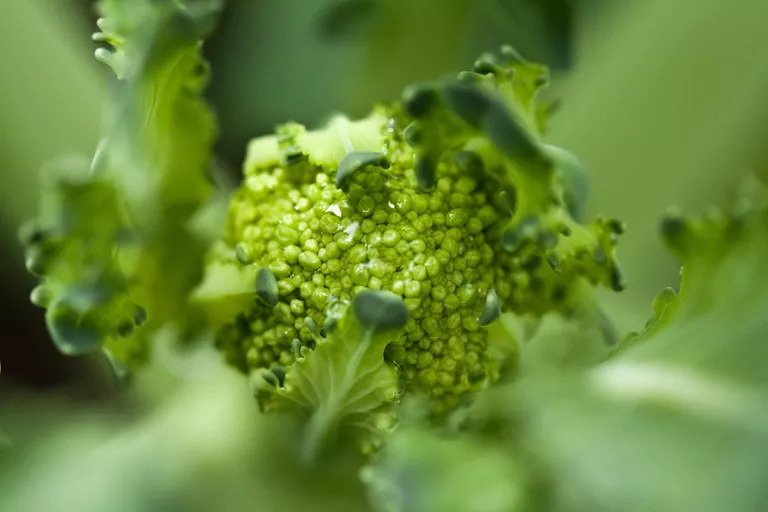How to Grow Broccoli
Former President George H.W. Bush may not have appreciated the green-headed vegetable his mother made him eat as a child. But there are plenty of us who would savor the tasty and nutritious benefits of learning how to grow broccoli.
A member of the mustard family, this cool-weather crop was originally cultivated in Italy from wild cabbage. Its Italian name, cabbage sprout, is derived from the Latin term for branch or arm, as in those of the tree it resembles.
Broccoli is one of the first plants that can grow in your garden each spring, in as little as 55 days, and one of the last to survive fall's frosts. It sprouts several heads. Chop off the central crown, generally maturing in 70 to 95 days, and it stimulates smaller side shoots for later pickings. The secondary heads can be harvested for weeks, until there's a hard freeze and before the flower buds begin to open.
Among cruciferous cole crops, such as the closely related cauliflower, broccoli contains one of the highest levels of the antioxidant vitamin C. It's also known to ward off cancer, lower cholesterol, and improve detoxification, anti-inflammatory, digestive and cardiovascular functions.
Experienced gardeners will tell you, mastering how to grow broccoli is a relatively easy undertaking.
Tools you'll need:
- Starter fertilizer
- General-purpose fertilizer
- Compost or manure
- Garden fork, spade or tiller
Site selection and timing:
- Choose a site in full sun.
- Broccoli thrives in a well-drained soil with plenty of calcium and a soil pH of 6 to 6.8.
- Plant as soon as the soil can be worked, about three months before the first expected fall frost, and harvest before hot weather.
- For indoor planting, sow seeds about 6 to 8 weeks before the average date of the last frost (frost-free date). Grow under lights or in a greenhouse. Transplant hardened-off, or acclimated, seedlings into the garden 2 to 4 weeks before the frost-free date.
Preparing the soil:
- Use a garden fork, spade or tiller to loosen the soil to a depth of 12 to 15 inches.
- Mix in a 2 to 4 inch layer of compost or manure
- Apply a complete garden fertilizer, such as 10-10-10.
How to plant:
- Space plants 18 to 24 inches apart, about 1⁄4 to 1⁄2 inch deep, and three feet between rows. Set transplants slightly deeper than they were originally grown.
- Apply starter fertilizer to transplants.
Tools for maintenance:
- Fertilizer
- Mulch
- Compost
- Cardboard collars
- Floating row covers
- Insect netting
- Organic sprays made from soap or garlic
Routine maintenance:
- Water regularly to keep soil moist, not wet, 1 to 2 inches a week.
- Mulch adds moisture and prevents weeds.
- As the plants start forming heads, apply a 5-10-10 fertilizer or compost around the base of the broccoli -- not the stem -- and water.
- Use a complete fertilizer when the plants are about half-grown, 10 to 12 inches tall.
- Thin plants to keep them 1 foot apart in all directions.
- To deter garden pests, use cardboard collars, insect netting or row covers. The latter also protects against cold.
- As an alternative to insecticides, try an organic approach such as soap or garlic sprays
Harvest cycles:
- Harvest when head buds are large and firm, forming individual florets with a compact cluster of small flower buds that have not begun to separate, revealing bright yellow petals inside.
- Cut central heads when they are 4 to 6 inches leaving 6 inches of stem attached so side shoots can continue to develop. They will reach only 1 to 2 inches in diameter.
Tips:
- Green Goliath and Green Comet are the most versatile, early producing and weather tolerant varieties. Cruiser is a high-yielder that's tolerant of dry conditions and Packman is a good summer or fall crop. Other fall suggestions include Arcadia and Waltham 29.
- To prevent soil, root and stem diseases, don't plant broccoli or other cabbage-family plants in the same spot more than once every three years.
- Broccoli thrives where previous crops were legumes such as peas or clover and alongside bush bean, beet, carrot, celery, cucumber, dill, lettuce, onion, potato, spinach and tomato.
- Avoid watering the broccoli head as it encourages flowering.
- Use cardboard collars to deter garden pests; windbreakers to prevent moisture loss; and row covers, newspaper, plastic cones, paper bags or baskets to protect from hard frosts.
- Soak heads in lightly salted water before cooking or storing to drive out any hidden cabbageworms.
Got more tips on how to grow broccoli? Leave them in the comments below.







No comments